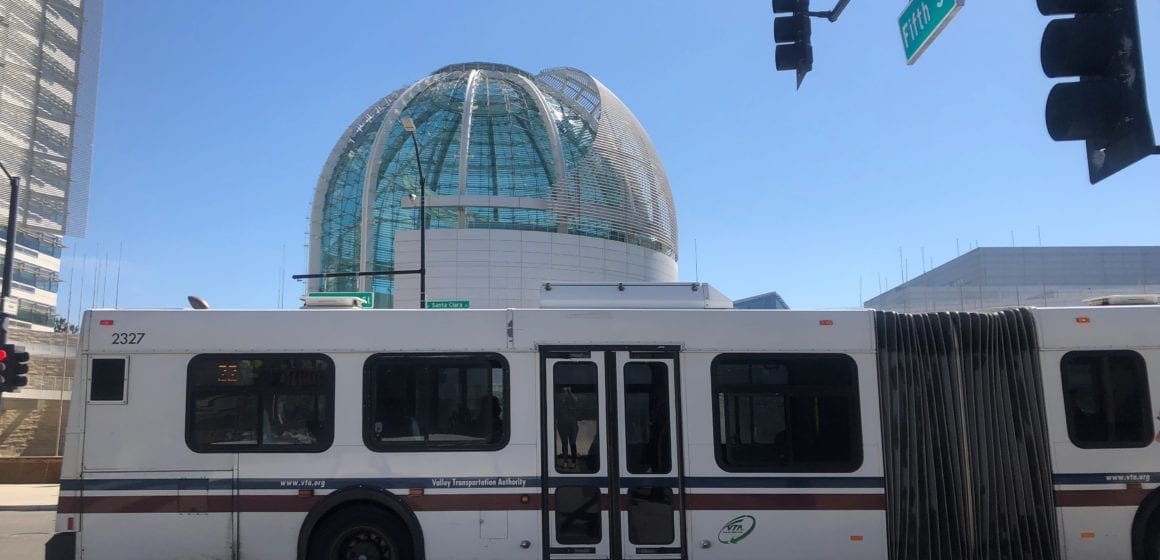Welcome to SV@Home’s Policy Rundown, your need-to-know overview of important housing policy actions and developments from the past two weeks.
VTA Board Considers Service Reductions That Impact Affordable Housing Development
On December 3rd, the VTA Board of Directors will take a final vote related to proposed service reductions to balance the VTA budget in response to the financial impact of COVID-19. The Board is considering several different options, ranging from a 10% reduction to a 30% reduction in service. SV@Home is very concerned that these reductions will not only have immediate impacts on lower-income residents of Santa Clara County but a range of other impacts on our ability to produce new affordable housing Countywide.
We know that reductions to public transit services will disproportionately impact lower-income workers across Santa Clara County, including a large number of essential employees and first responders who have kept our economy functional in the face of COVID-19. For this reason, it is crucial that the VTA Board do everything within its power, including using Measure B funds, in order to mitigate the worst levels of service reduction and maintain service levels at the 90% option (which only reduces service by 10% from its current level).
As the State of California and local jurisdictions have adopted policies to incentivize affordable housing development that is accessible to transit options, transportation criteria such as proximity to frequent transit headways have become key factors in housing approval processes and the competition for scarce financing resources. Even if the VTA Board approves the 90% service level option, certain affordable housing development proposals that are making use of transit-oriented development incentives could be jeopardized and CEQA analyses could be disrupted.
While there is some indication that the State of California will permit some flexibility in these areas to account for COVID-specific service disruptions, it is imperative that the Board explicitly clarify that the proposed service reductions are temporary and will be restored after the end of the pandemic. This will provide assurances to the state and assist affordable housing developers working to ensure critical affordable housing projects continue to move forward.
The Turnout4Transit campaign has more information about the proposed service reductions and how to take action on their website.
San José Releases Draft Diridon Station Area Plan (DSAP) Amendments
Last week, the City of San José released the draft amended Diridon Station Area Plan (DSAP), which sets the framework for development for the entire 250-acre area encompassing Diridon Station in Downtown San José. Those who have been tracking development around Diridon closely will remember that earlier this month, Google submitted its Downtown West proposal for the land that it owns in the Station Area, encompassing roughly 80 acres. And while Google’s proposal is the largest in the entire planning area and will serve as a catalyst for the new neighborhood, the amended DSAP is critical to defining how development will unfold in the rest of the Station Area, making or breaking its success as a vibrant, mixed-use transit hub.
SV@Home has collaborated closely with the City of San José, including as a member of the Station Area Advisory Group (SAAG), to ensure that the DSAP plans for a significant amount of housing and affordable housing. We’ve advocated for the fulfillment of our Housing Vision for the Station Area, which we believe should plan for at least 15,000 new homes — 25% of which must be affordable – among other key housing points. Based on our analysis of the draft DSAP amendments, we believe that the staff proposal is in line with our Housing Vision. Despite this, we know that there are several important areas that must be confirmed and clarified to ensure the Vision can still be achieved. Namely:
- There should be no reductions in the currently proposed residential capacities or the areas that have been designated for residential development. There have been discussions regarding whether the maximum building heights in the southern area of the DSAP should be modified or reduced, which would have a major impact on the part of the planning area that has been targeted for new housing development. Any reductions to heights in this area, or any other DSAP areas, will significantly reduce the amount of new homes and, critically, the amount of affordable homes that can be developed in the Station Area.
- The Caltrain and VTA-owned parcels adjacent to Diridon Station, which had previously been incorporated into the Downtown West proposal, should be prioritized for housing development. There remain outstanding questions related to the development capacity of these parcels, due to uncertainties surrounding the design of the new station (the DISC: Diridion Integrated Station Concept). However, their proximity to the Station itself and their ownership by Caltrain and VTA make them important candidates for housing and affordable housing development.
We are also looking forward to receiving more details about the City of San José’s Affordable Housing Implementation Plan for the Station Area, which we anticipate will be released very soon. This Plan will be crucial in defining how the Plan will reach its 25% affordability target, which was already approved by the City Council and has strong support among affordable housing advocates.
There are a number of upcoming opportunities to get engaged and provide feedback on both the Downtown West proposal and the draft DSAP amendments. The City of San José put together this helpful page that lists these opportunities, including the upcoming SAAG meeting on November 9th and the San José City Council Study Session on November 16th. There is also a feedback form on the draft DSAP amendments at the bottom of this page.
Santa Clara County Receives Additional Project Homekey Funding while Milpitas Mulls over Litigation to Reject Funding due to Community Opposition
Last month, Governor Newsom announced the latest funding round for Project Homekey, including $9.5m for Santa Clara County. The funding will be used to acquire a 54-unit property that will serve as permanent housing and interim housing, both with supportive services for people who previously experienced homelessness. The property will eventually be developed into 110 units of new permanent supportive housing. More information on Project Homekey is available at the HCD website.
In related news, the Milpitas City Council has voted unanimously to consider bringing litigation against the State of California and others involved in the Project Homekey program following a public outcry regarding the proposal at 1000 Hillview Court. The proposal would see the conversion of the Extended Stay Hotel to create 132 affordable permanent supportive homes for members of our community who are experiencing homelessness. Spearheaded by Jamboree Housing, in partnership with Destination: Home, the proposal is also set to receive funds from Santa Clara County’s 2016 Measure A affordable housing bond.
SV@Home condemns the City’s proposed course of action and strongly supports Jamboree Housing’s proposal. The pandemic has brought into even sharper relief the dire need for permanent housing for people experiencing homelessness in our community. These housing opportunities are literally saving lives. The City of Milpitas initially supported this project and should be doing everything in its power to move this proposal forward and be a part of the solution to ending homelessness in Santa Clara County. To learn more about the proposal, and why it’s so critical we provide more homes for our neighbors experiencing homelessness, check out (and consider signing) this petition.
What does the State Eviction Moratorium mean for you?
To help residents understand their rights and responsibilities under the current state eviction moratorium, enacted under AB 3088, SV@Home will be providing periodic updates on the law and how it applies to you.
Who can get evicted now, and what is the timeline for future evictions?
Under the state eviction moratorium, AB 3088, tenants cannot be evicted for nonpayment of rent if they have been financially affected by the COVID-19 pandemic. Tenants MUST fill out a signed declaration of financial distress within 15 days of a notice to pay or quit to claim that right. Any notice to pay or quit from a landlord should include the declaration form, but a declaration form can also be found here.
Tenants can currently be evicted for reasons other than nonpayment of rent, such as violating the lease.
On February 1st, 2021, evictions will resume unless new laws are passed.
Who has to pay what now, and what is the timeline for future payments?
If you owe rent that was due from March 1, 2020 – August 31, 2020: If you return the declaration to your landlord in time, you cannot be evicted for not paying this rent.
If you owe that was due from September 1, 2020 – January 31, 2021. You will need to pay : pay 25% of the total rent owed by no later than January 31, 2021. The other 75% of rent is converted into consumer debt and the tenant can never be evicted for not paying it. You will be required to resend the AB 3088 compliant declaration (link to declaration) each time your landlord serves you a new 15-day notice.
Landlords can still sue in small claims court to collect back rent. Tenants who are able to pay rent should continue to pay.
More information about AB 3088 and other COVID eviction protections can be found here.

